Mechanical Behavior of Plaster Composites Based on Rubber Particles from End-of-Life Tires Reinforced with Carbon Fibers
Abstract
:1. Introduction
2. Materials and Methods
2.1. Materials
2.1.1. End-of-Life Tire (ELT) Rubber Waste
2.1.2. Carbon Fibers
2.2. Dosages
2.3. Tests
3. Results and Discussion
3.1. Shore C Hardness
3.2. Density
3.3. Flexural Strength
3.4. Compressive Strength
3.5. Young’s Modulus
3.6. Stress–Strain
3.7. Microstructure
4. Conclusions
5. Patents
Author Contributions
Funding
Institutional Review Board Statement
Informed Consent Statement
Data Availability Statement
Acknowledgments
Conflicts of Interest
References
- Dixit, A. A study on the physical and chemical parameters of industrial by-products ashes useful in making sustainable concrete. Mater. Today Proc. 2021, 43, 42–50. [Google Scholar] [CrossRef]
- Afolabi, L.O.; Elfaghi, A.M.; Alomayri, T.; Arogundade, A.I.; Mahzan, S.; Isa, N.M.; Saw, C.L.; Otitoju, T.A. Thermal energy storage phase change material cement mortar incorporated with clinical waste composites. Int. J. Energy Res. 2021, 45, 13575–13590. [Google Scholar] [CrossRef]
- Kumar, D.C.; Vasanthi, P.; Devaraju, A. Experimental studies on composite bricks using black cotton soil, fly ash and granite waste. Mater. Today Proc. 2021, 39, 868–874. [Google Scholar] [CrossRef]
- Vidales-Barriguete, A.; Santa-Cruz-Astorqui, J.; Piña-Ramírez, C.; Kosior-Kazberuk, M.; Kalinowska-Wichrowska, K.; Atanes-Sánchez, E. Study of the Mechanical and Physical Behavior of Gypsum Boards with Plastic Cable Waste Aggregates and Their Application to Construction Panels. Materials 2021, 14, 2255. [Google Scholar] [CrossRef]
- Nim, A.; Meshram, K. Impact of eco friendly blast furnace slag on production of building blocks. Staveb. Obz. Civ. Eng. J. 2020, 29, 573–582. [Google Scholar] [CrossRef]
- Arumugam, C.; Shaik, S. Transforming waste disposals into building materials to investigate energy savings and carbon emission mitigation potential. Environ. Sci. Pollut. Res. 2021, 28, 15259–15273. [Google Scholar] [CrossRef]
- Kavyateja, B.V.; Reddy, P.N. Effect of Industrial Waste on Strength Properties of Concrete. Ann. Chim. Sci. Matér. 2020, 44, 353–358. [Google Scholar] [CrossRef]
- Council Directive 1999/31/EC of 26 April 1999 on the Landfill of Waste; Council of the European Union: Brussels, Belgium, 1999.
- Bianco, I.; Panepinto, D.; Zanetti, M. End-of-Life Tyres: Comparative Life Cycle Assessment of Treatment Scenarios. Appl. Sci. 2021, 11, 3599. [Google Scholar] [CrossRef]
- Fazli, A.; Rodrigue, D. Recycling Waste Tires into Ground Tire Rubber (GTR)/Rubber Compounds: A Review. J. Compos. Sci. 2020, 4, 103. [Google Scholar] [CrossRef]
- Valentín, J.L.; Pérez-Aparicio, R.; Fernandez-Torres, A.; Posadas, P.; Herrero, R.; Salamanca, F.M.; Navarro, R.; Saiz-Rodríguez, L. Advanced characterization of recycled rubber from end-of-life tires. Rubber Chem. Technol. 2020, 93, 683–703. [Google Scholar] [CrossRef]
- Diez, R.V.L.; Zaldivar, O.L.; del Cura, S.H.; Lobo, P.L.M.; Hernández-Olivares, F. Influencia de la incorporación de fibras de caucho procedente de neumáticos fuera de uso (NFU) en morteros de yeso. Estudio de las propiedades mecánicas, térmicas y acústicas. Dyna 2019, 4, 460–464. [Google Scholar] [CrossRef]
- Segre, N.; Joekes, I. Use of tire rubber particles as addition to cement paste. Cem. Concr. Res. 2000, 30, 1421–1425. [Google Scholar] [CrossRef]
- Petrella, A.; Notarnicola, M. Lightweight Cement Conglomerates Based on End-of-Life Tire Rubber: Effect of the Grain Size, Dosage and Addition of Perlite on the Physical and Mechanical Properties. Materials 2021, 14, 225. [Google Scholar] [CrossRef]
- Fantilli, A.P.; Chiaia, B. Mechanical performances of mortar prisms and concrete slabs incorporating rubber aggregates. Mech. Res. Commun. 2018, 92, 118–123. [Google Scholar] [CrossRef]
- Roychand, R.; Gravina, R.J.; Zhuge, Y.; Ma, X.; Youssf, O.; Mills, J.E. A comprehensive review on the mechanical properties of waste tire rubber concrete. Constr. Build. Mater. 2020, 237, 117651. [Google Scholar] [CrossRef]
- Eldin, N.; Senouci, A. Rubber-Tire Particles as Concrete Aggregate. J. Mater. Civ. Eng. 1993, 5, 478–496. [Google Scholar] [CrossRef]
- Gupta, T.; Siddique, S.; Sharma, R.K.; Chaudhary, S. Investigating mechanical properties and durability of concrete containing recycled rubber ash and fibers. J. Mater. Cycles Waste Manag. 2021, 23, 1048–1057. [Google Scholar] [CrossRef]
- Herrero-del-Cura, S.; Mayor-Lobo, P.L.; Hernández-Olivares, F. Influence of proportion and particle size gradation of rubber from end-of-life tires on mechanical, thermal, and acoustic properties of plaster-rubber mortars. Mater. Des. 2013, 47, 633–642. [Google Scholar] [CrossRef] [Green Version]
- Turatsinze, A.; Bonnet, S.; Granju, J.-L. Mechanical characterisation of cement-based mortar incorporating rubber aggregates from recycled worn tyres. Build. Environ. 2005, 40, 221–226. [Google Scholar] [CrossRef]
- Fazli, A.; Rodrigue, D. Waste Rubber Recycling: A Review on the Evolution and Properties of Thermoplastic Elastomers. Materials 2020, 13, 782. [Google Scholar] [CrossRef] [PubMed] [Green Version]
- Hernández-Olivares, F.; Barluenga, G.; Bollati, M.; Witoszek, B. Static and dynamic behaviour of recycled tyre rubber-filled concrete. Cem. Concr. Res. 2002, 32, 1587–1596. [Google Scholar] [CrossRef]
- Ghizda˘veț, Z.; Ștefan, B.M.; Nastac, D.; Vasile, O.; Bratu, M. Sound absorbing materials made by embedding crumb rubber waste in a concrete matrix. Constr. Build. Mater. 2016, 124, 755–763. [Google Scholar] [CrossRef]
- Milad, A.; Ahmeda, A.G.F.; Taib, A.M.; Rahmad, S.; Solla, M.; Yusoff, N.I.M. A review of the feasibility of using crumb rubber derived from end-of-life tire as asphalt binder modifier. J. Rubber Res. 2020, 23, 1–14. [Google Scholar] [CrossRef]
- López-Zaldívar, O.; Lozano-Díez, R.V.; Herrero-del-Cura, S.; Mayor-Lobo, P.L.; Hernández-Olivares, F. Effects of water absorption on the microstructure of plaster with end-of-life tire rubber mortars. Constr. Build. Mater. 2017, 150, 558–567. [Google Scholar] [CrossRef]
- Benazzouk, A.; Douzane, O.; Mezreb, K.; Laidoudi, B.; Quéneudec, M. Thermal conductivity of cement composites containing rubber waste particles: Experimental study and modelling. Constr. Build. Mater. 2008, 22, 573–579. [Google Scholar] [CrossRef]
- Hernández-Olivares, F.; Barluenga, G. Fire performance of recycled rubber-filled high-strength concrete. Cem. Concr. Res. 2004, 34, 109–117. [Google Scholar] [CrossRef]
- Fedroff, D.; Ahmed, S.; Savas, D.Z. Mechanical properties of concrete with ground waste tire rubber. Trans. Res. Rec. 1996, 1532, 66–72. [Google Scholar] [CrossRef]
- Khaloo, A.R.; Dehestani, M.; Rahmatabadi, P. Mechanical properties of concrete containing a high volume of tire–rubber particles. Waste Manag. 2008, 28, 2472–2482. [Google Scholar] [CrossRef]
- Girskas, G.; Nagrockienė, D. Crushed rubber waste impact of concrete basic properties. Constr. Build. Mater. 2017, 140, 36–42. [Google Scholar] [CrossRef]
- Hsie, M.; Tu, C.; Song, P. Mechanical properties of polypropylene hybrid fiber-reinforced concrete. Mater. Sci. Eng. A 2008, 494, 153–157. [Google Scholar] [CrossRef]
- Ralegaonkar, R.; Gavali, H.; Aswath, P.; Abolmaali, S. Application of chopped basalt fibers in reinforced mortar: A review. Constr. Build. Mater. 2018, 164, 589–602. [Google Scholar] [CrossRef]
- Del Río Merino, M.; Hernández Olivares, F.; Comino Almenara, P. Estado del arte sobre el comportamiento físico-mecánico de la escayola reforzada con fibras de vidrio E. Inf. Constr. 2004, 56, 33. [Google Scholar]
- Alberti, M.; Enfedaque, A.; Galvez, J. Comparison between polyolefin fibre reinforced vibrated conventional concrete and self-compacting concrete. Constr. Build. Mater. 2015, 85, 182–194. [Google Scholar] [CrossRef]
- Herrero-del-Cura, S.; López-Zaldívar, O.; Lozano-Díez, R.V.; Mayor-Lobo, P.L.; Hernández-Olivares, F. Experimental analysis of the incorporation of different fibers in the mechanical behaviour of plaster and ELT rubber composites. An. Edif. 2019, 5, 1–7. [Google Scholar] [CrossRef]
- Rodríguez-Liñán, C.; Morales-Conde, M.; Rubio-De-Hita, P.; Pérez-Gálvez, F.; Pedreño-Rojas, M.A. The Influence of Natural and Synthetic Fibre Reinforcement on Wood-Gypsum Composites. Open Constr. Build. Technol. J. 2017, 11, 350–362. [Google Scholar] [CrossRef] [Green Version]
- Chung, D.; Zheng, Q. Electronic properties of carbon fiber reinforced gypsum plaster. Compos. Sci. Technol. 1989, 36, 1–6. [Google Scholar] [CrossRef]
- Dong, Y.F.; Zhou, L.; Hao, W.J.; Yi, Y.Y.; Zhao, H.C.; Yu, X.D. The Study of Absorbing Property of λ/4 Type Absorber Made of Carbon Fiber Membrane and Gypsum Board. Adv. Mater. Res. 2014, 1030–1032, 236–240. [Google Scholar] [CrossRef]
- Zhang, B.; Tian, Y.; Jin, X.; Lo, T.Y.; Cui, H. Thermal and Mechanical Properties of Expanded Graphite/Paraffin Gypsum-Based Composite Material Reinforced by Carbon Fiber. Materials 2018, 11, 2205. [Google Scholar] [CrossRef] [Green Version]
- Chuang, W.; Geng-Sheng, J.; Bing-Liang, L.; Lei, P.; Ying, F.; Ni, G.; Ke-Zhi, L. Dispersion of carbon fibers and conductivity of carbon fiber-reinforced cement-based composites. Ceram. Int. 2017, 43, 15122–15132. [Google Scholar] [CrossRef]
- Hou, L.; Wu, R.; Wang, X.; Zhang, J.; Zhang, M.; Dong, A.; Sun, B. Microstructure, mechanical properties and thermal conductivity of the short carbon fiber reinforced magnesium matrix composites. J. Alloy. Compd. 2017, 695, 2820–2826. [Google Scholar] [CrossRef]
- Han, B.; Zhang, L.; Zhang, C.; Wang, Y.; Yu, X.; Ou, J. Reinforcement effect and mechanism of carbon fibers to mechanical and electrically conductive properties of cement-based materials. Constr. Build. Mater. 2016, 125, 479–489. [Google Scholar] [CrossRef] [Green Version]
- Pham, P.N.; Zhuge, Y.; Turatsinze, A.; Toumi, A.; Siddique, R. Application of rubberized cement-based composites in pavements: Suitability and considerations. Constr. Build. Mater. 2019, 223, 1182–1195. [Google Scholar] [CrossRef]
- Turatsinze, A.; Garros, M. On the modulus of elasticity and strain capacity of Self-Compacting Concrete incorporating rubber aggregates. Resour. Conserv. Recycl. 2008, 52, 1209–1215. [Google Scholar] [CrossRef]
- Herrero-del-Cura, S.; López-Zaldívar, O.; Lozano-Díez, R.V.; Hernández-Olivares, F.; Mayor-Lobo, P.L. Yeso Aligerado con Polvo de Caucho Procedente de Neumáticos fuera de Uso (NFU) y Reforzado con Fibras de Carbono, su Procedimiento de Obtención y Su Uso. Spanish Patent ES2732159-B2, 13 March 2020. [Google Scholar]
- AENOR. Yesos de Construcción y Conglomerantes a Base de yeso para la Construcción. Parte 2: Métodos de Ensayo; UNE-EN 13279-2:2014; AENOR: Madrid, Spain, 2014. [Google Scholar]
- AENOR. Yesos de Construcción y Conglomerantes a Base de yeso para la Construcción. Parte 1: Definiciones y Especificaciones; UNE-EN 13279-1:2009; AENOR: Madrid, Spain, 2009. [Google Scholar]
- AENOR. Ensayos de Hormigón en Estructuras. Parte 4: Determinación de la Velocidad de los Impulsos Ultrasónicos; UNE-EN 12504-4 2006; AENOR: Madrid, Spain, 2006. [Google Scholar]

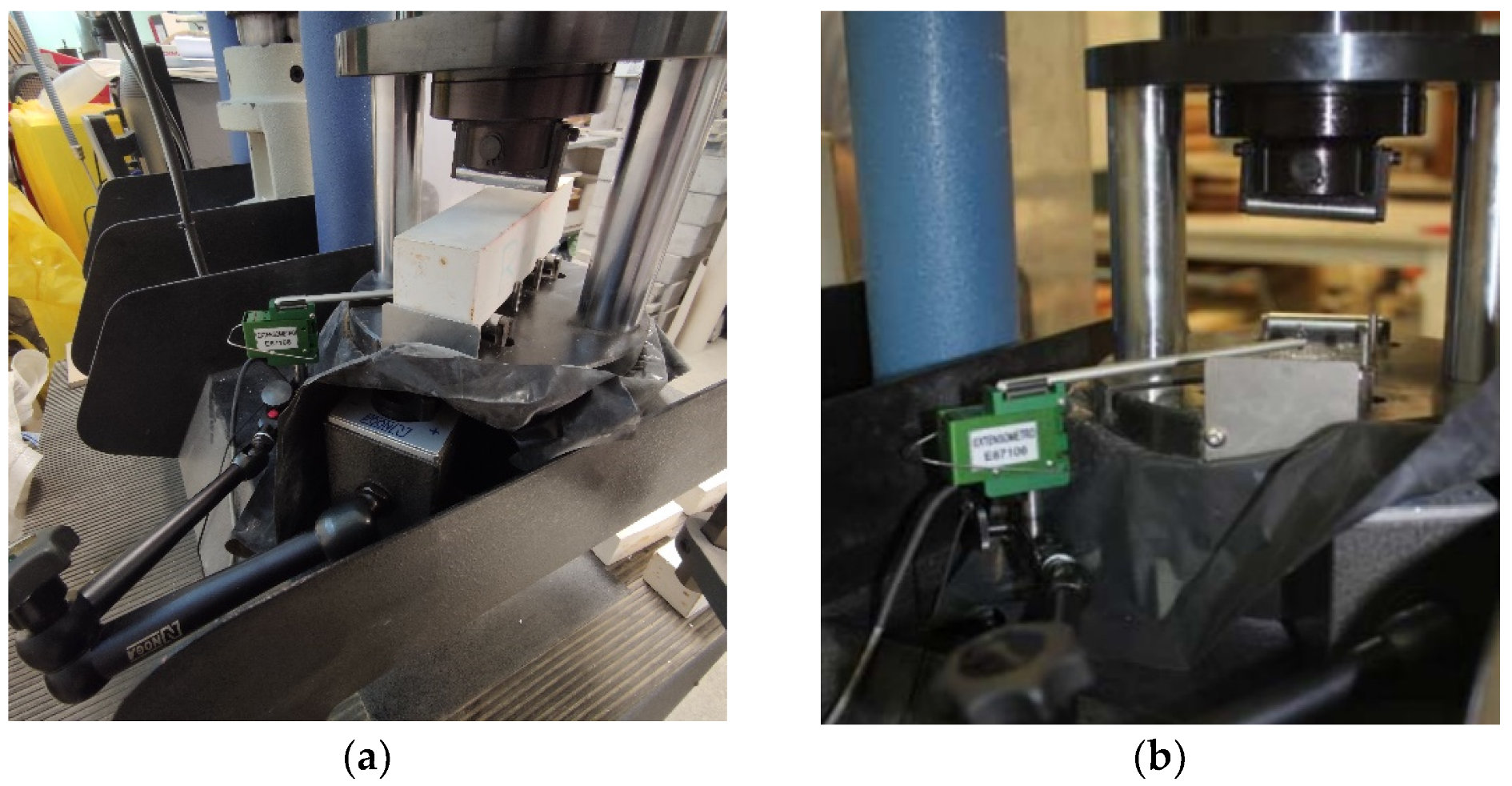
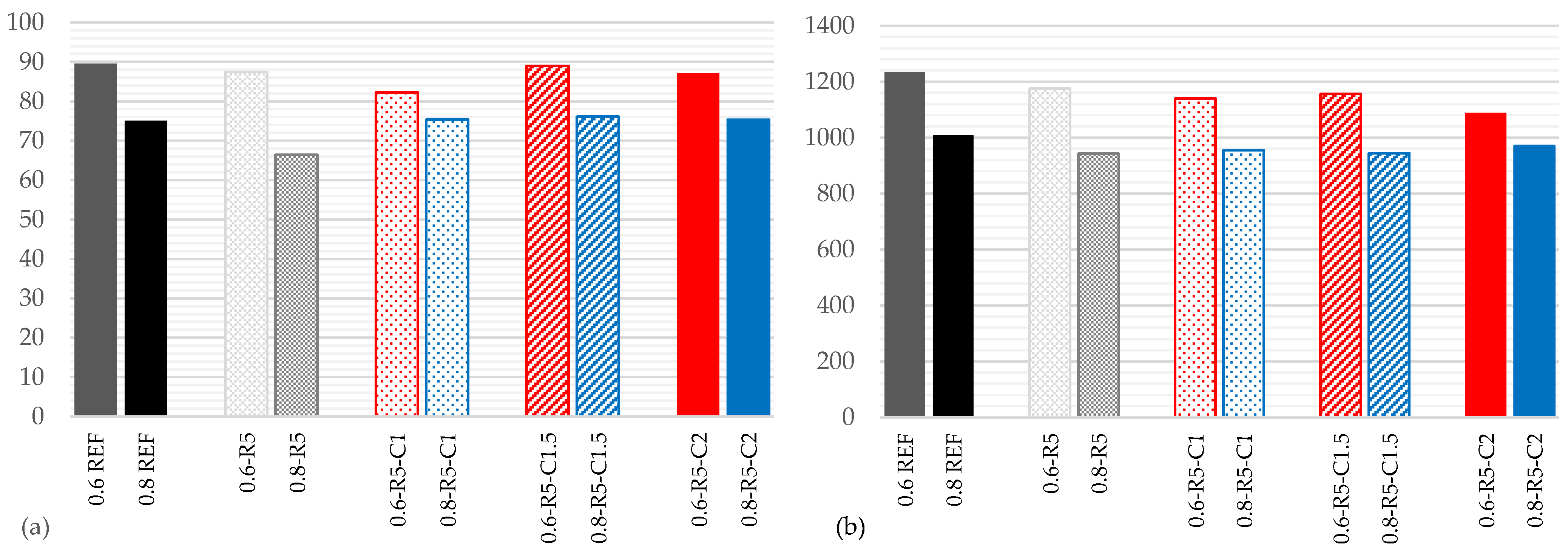
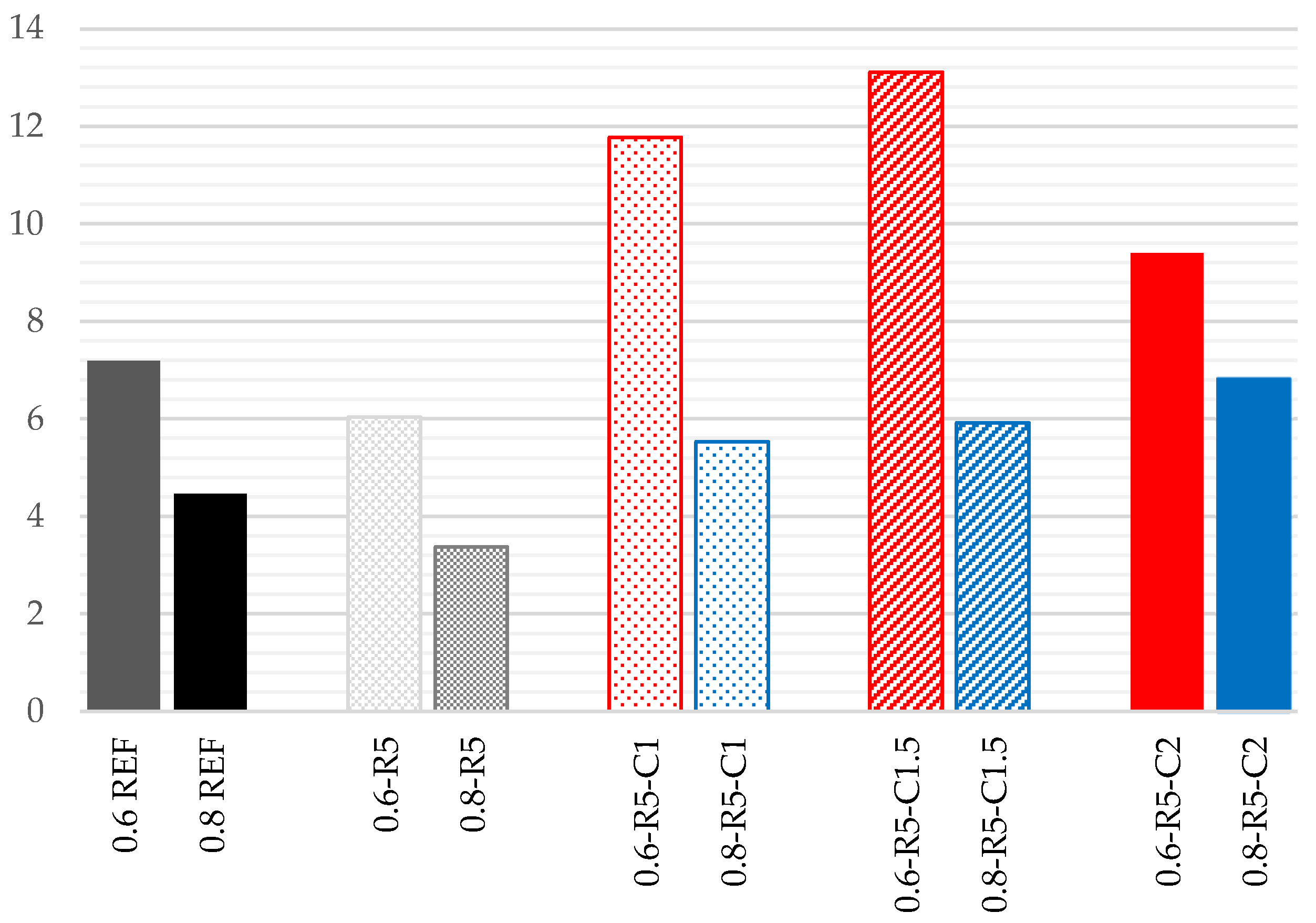
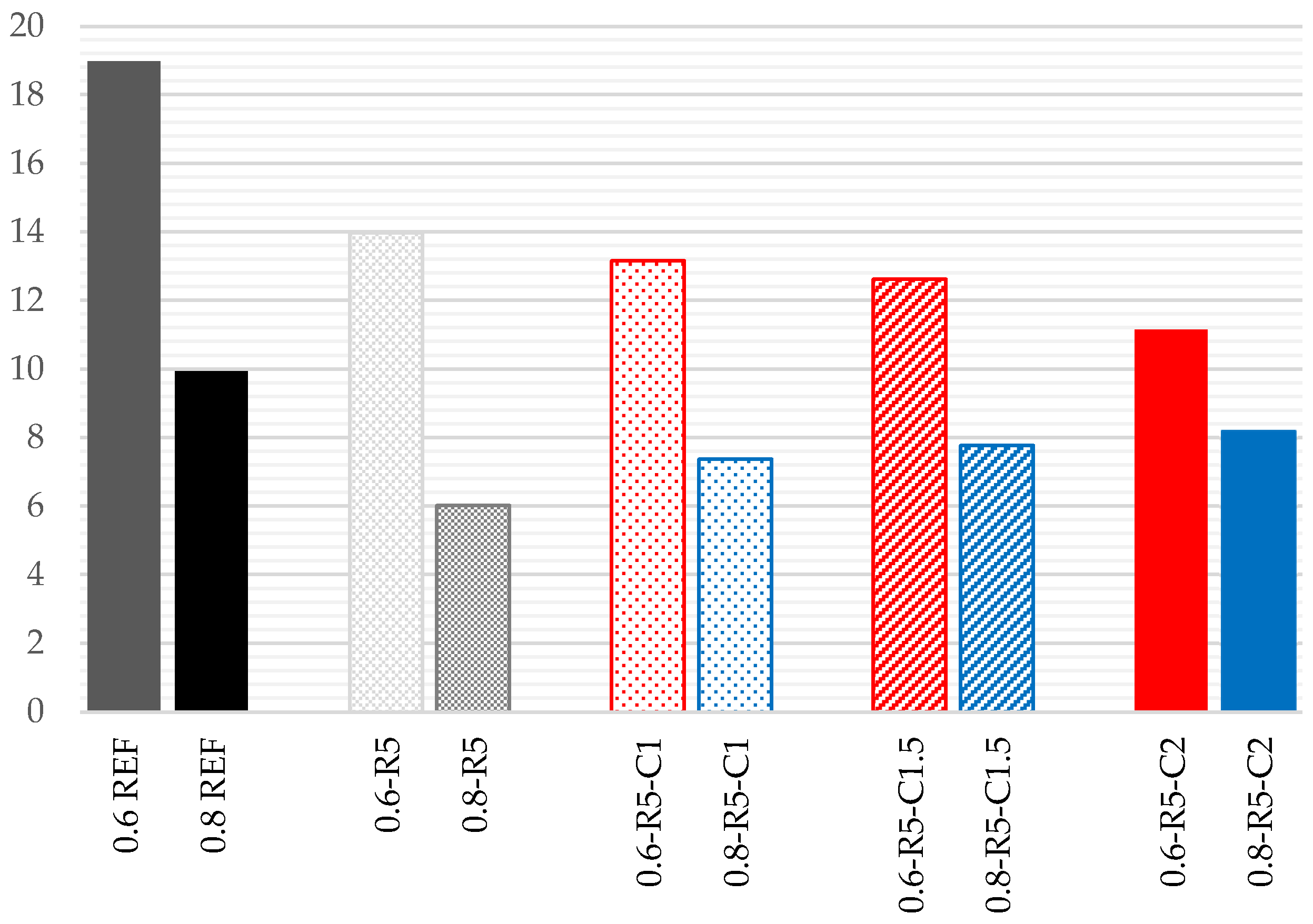
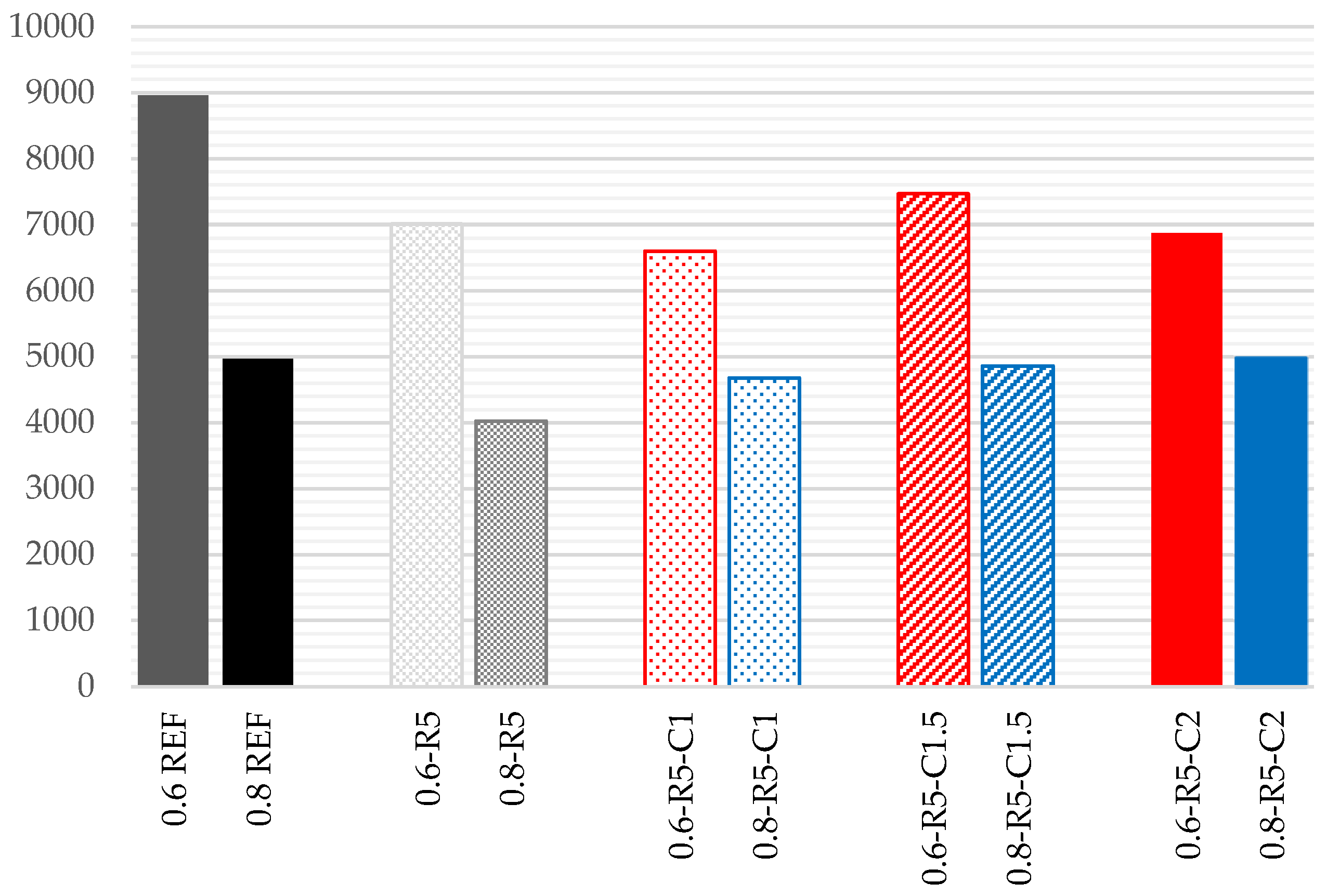
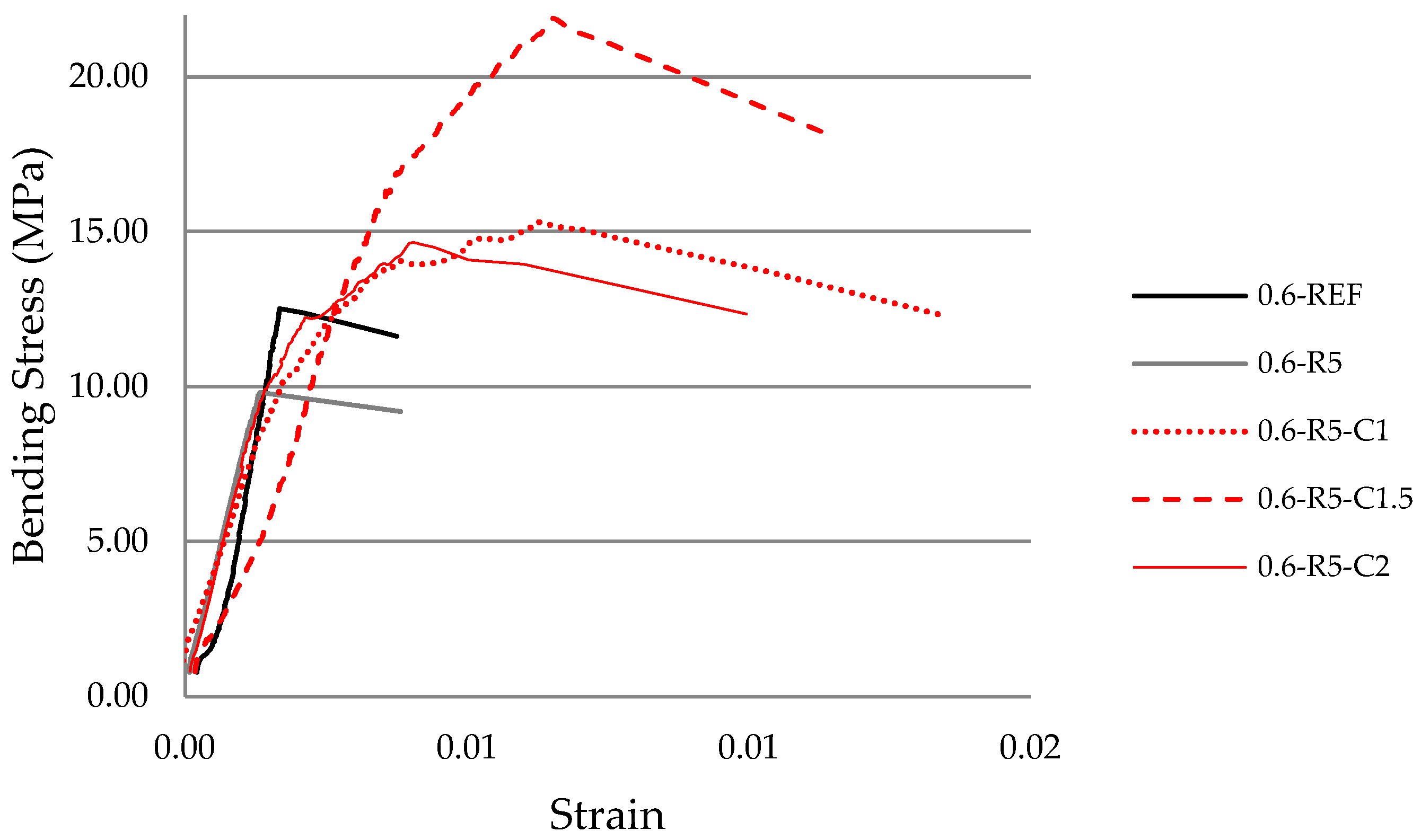
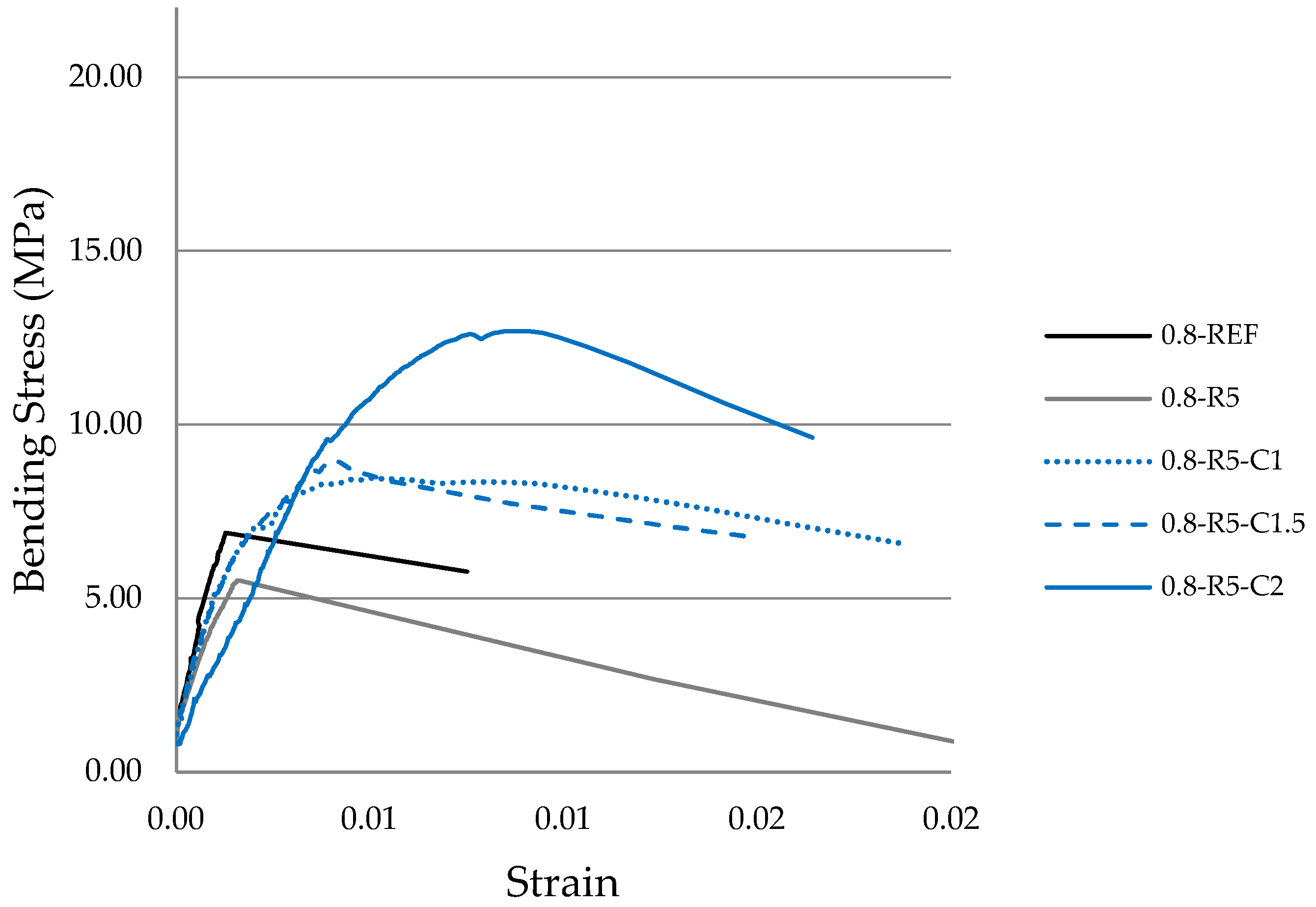
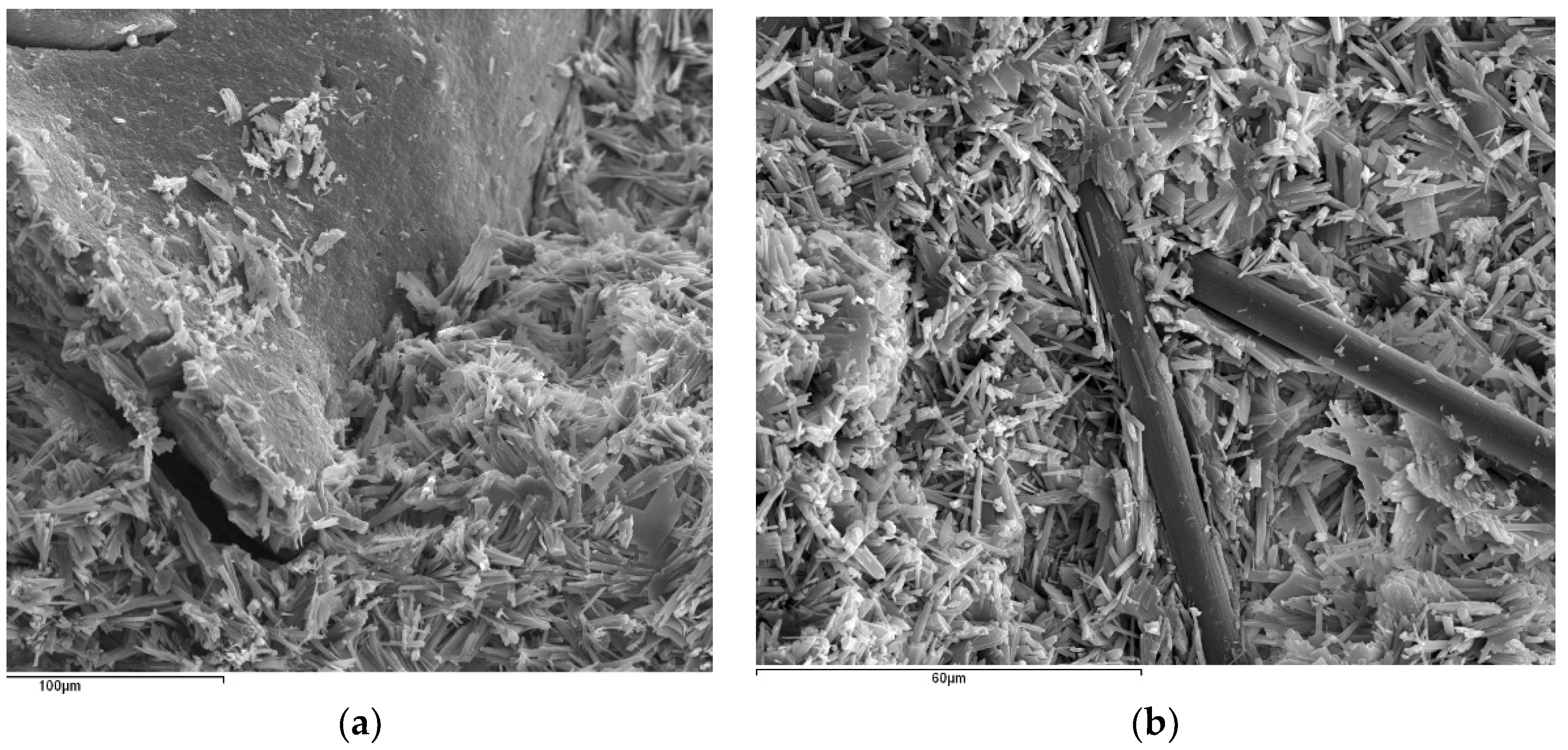

| Mixing water | 75% |
| Purity Index | 92% |
| Mechanical flexural tensile strength | ≥3.5 |
| Initial setting time (A/E = 0.8) | 6–12 min |
| Final setting time (A/E = 0.8) | 20–25 min |
| Whiteness index | >85% |
| Granulometry | Retention <1% in a 200-micron mesh sieve according to UNE standard |
| Water of crystallization | 5.2–6.2% |
| Chemical Analysis: | Minimum (%) | Maximum (%) |
|---|---|---|
| Ketone extract | 10 | 20 |
| NR/SR polymers | 40 | 55 |
| Natural rubber (NR) | 21 | 42 |
| Carbon black | 30 | 38 |
| Ashes | 3 | 7 |
| Sulfur | - | 5 |
| Physical Properties | ||
| Apparent density | 0.5 ± 0.05 g/cm³ | |
| Water content | <0.75% in weight | |
| Ferromagnetic materials | <0.01% in weight | |
| Textile material content | <0.25% in weight | |
| Other impurity content | <0.25% in weight | |
| Nominal Sieve Aperture | % Passes through Each Sieve | |
|---|---|---|
| Minimum% | Maximum% | |
| 0.800 | 100 | 100 |
| 0.500 | 50 | 80 |
| 0.250 | 5 | 30 |
| 0.125 | 0 | 10 |
| 0.063 | 0 | 5 |
| Type of Fiber | Density (g/m3) | Length (mm) | Diameter (µm) | Modulus of Elasticity (GPa) | Ultimate Elongation (%) |
|---|---|---|---|---|---|
| Carbon | 1.95 | 12 | 100 | 230 | 2.1 |
| Compound | % Rubber (Weight) | Rubber (g) | % Carbon Fiber (Weight) | Carbon Fiber (g) | w/g1 Ratio | Water (g) | Gypsum (g) |
|---|---|---|---|---|---|---|---|
| 0.6-REF | 0 | 0 | 0 | 0 | 0.6 | 600 | 1000 |
| 0.6-R5 | 5 | 50 | 0 | 0 | 0.6 | 600 | 950 |
| 0.6-R5-C1 | 5 | 50 | 1 | 10 | 0.6 | 600 | 940 |
| 0.6-R5-C1.5 | 5 | 50 | 1.5 | 15 | 0.6 | 600 | 935 |
| 0.6-R5-C2 | 5 | 50 | 2 | 20 | 0.6 | 600 | 930 |
| 0.8-REF | 0 | 0 | 0 | 0 | 0.8 | 800 | 1000 |
| 0.8-R5 | 5 | 50 | 0 | 0 | 0.8 | 800 | 950 |
| 0.8-R5-C1 | 5 | 50 | 1 | 10 | 0.8 | 800 | 940 |
| 0.8-R5-C1.5 | 5 | 50 | 1.5 | 15 | 0.8 | 800 | 935 |
| 0.8-R5-C2 | 5 | 50 | 2 | 20 | 0.8 | 800 | 930 |
| Compound | Superficial Hardness (Shore C) | Density (kg/m3) | Flexural Strength (MPa) | Compressive Strength (MPa) | Young’s Modulus (MPa) |
|---|---|---|---|---|---|
| 0.6-REF | 89.57 | 1234.19 | 7.20 | 18.98 | 8961.41 |
| 0.6-R5 | 87.50 | 1175.49 | 6.04 | 13.97 | 7017.62 |
| 0.6-R5-C1 | 82.27 | 1140.95 | 11.78 | 13.16 | 6602.02 |
| 0.6-R5-C1.5 | 89.03 | 1156.69 | 13.12 | 12.63 | 7473.05 |
| 0.6-R5-C2 | 87.07 | 1088.68 | 9.40 | 11.15 | 6879.63 |
| 0.8-REF | 75.10 | 4.47 | 9.93 | 4973.57 | |
| 0.8-R5 | 66.47 | 943.88 | 3.38 | 6.03 | 4024.81 |
| 0.8-R5-C1 | 75.37 | 955.18 | 5.53 | 7.37 | 4682.46 |
| 0.8-R5-C1.5 | 76.13 | 944.27 | 5.92 | 7.77 | 4859.61 |
| 0.8-R5-C2 | 75.47 | 970.94 | 6.83 | 8.19 | 4982.98 |
| w/g1 | REF | R5 | R5-C1 | R5-C1.5 | R5-C2 | |
|---|---|---|---|---|---|---|
| 0.6 | Resistance (MJ/m3) | 0.007 | 0.006 | 0.011 | 0.033 | 0.014 |
| Toughness (MJ/m3) | 0.033 | 0.030 | 0.171 | 0.360 | 0.120 | |
| 0.8 | Resistance (MJ/m3) | 0.005 | 0.004 | 0.004 | 0.005 | 0.022 |
| Toughness (MJ/m3) | 0.045 | 0.070 | 0.139 | 0.107 | 0.164 |
Publisher’s Note: MDPI stays neutral with regard to jurisdictional claims in published maps and institutional affiliations. |
© 2021 by the authors. Licensee MDPI, Basel, Switzerland. This article is an open access article distributed under the terms and conditions of the Creative Commons Attribution (CC BY) license (https://creativecommons.org/licenses/by/4.0/).
Share and Cite
Lozano-Díez, R.V.; López-Zaldívar, Ó.; Herrero-del-Cura, S.; Mayor-Lobo, P.L.; Hernández-Olivares, F. Mechanical Behavior of Plaster Composites Based on Rubber Particles from End-of-Life Tires Reinforced with Carbon Fibers. Materials 2021, 14, 3979. https://doi.org/10.3390/ma14143979
Lozano-Díez RV, López-Zaldívar Ó, Herrero-del-Cura S, Mayor-Lobo PL, Hernández-Olivares F. Mechanical Behavior of Plaster Composites Based on Rubber Particles from End-of-Life Tires Reinforced with Carbon Fibers. Materials. 2021; 14(14):3979. https://doi.org/10.3390/ma14143979
Chicago/Turabian StyleLozano-Díez, Rafael Vicente, Óscar López-Zaldívar, Sofía Herrero-del-Cura, Pablo Luís Mayor-Lobo, and Francisco Hernández-Olivares. 2021. "Mechanical Behavior of Plaster Composites Based on Rubber Particles from End-of-Life Tires Reinforced with Carbon Fibers" Materials 14, no. 14: 3979. https://doi.org/10.3390/ma14143979






